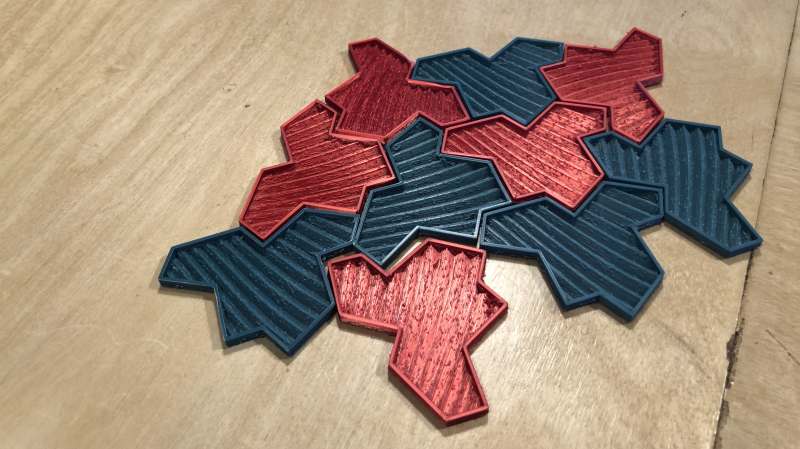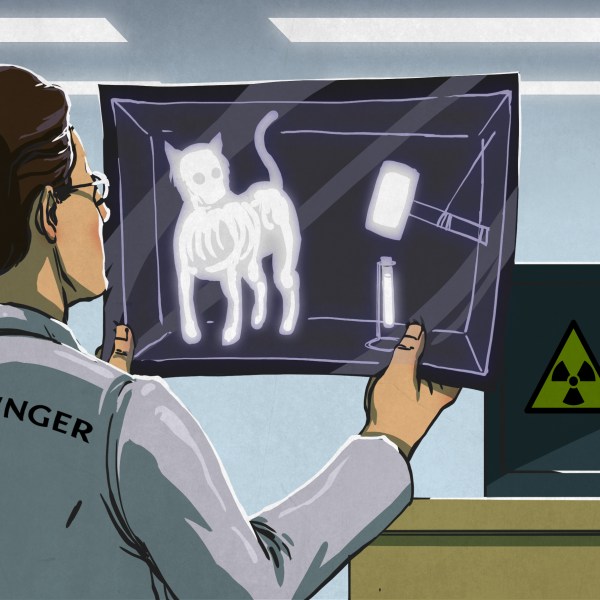Ah, tiles. You can get square ones, and do a grid, or you can get fancier shapes and do something altogether more complex. By and large though, whatever pattern you choose, it will normally end up repeating on some scale or other. That is, unless you go with something like a Penrose Wave Tile. Discovered by mathematician Roger Penrose, they never exactly repeat, no matter how you lay them out.
[carterhoefling14] decided to try and create Penrose tiles at home—with a 3D printer being the perfect route to do it. Creating the tiles was simple—the first step was to find a Penrose pattern image online, which could then be used as the basis to design the 3D part in Fusion 360. From there, the parts were also given an inner wave structure to add further visual interest. The tiles were then printed to create a real-world Penrose tile form.
You could certainly use these Penrose tiles as decor, though we’d make some recommendations if you’re going that path. For one, you’ll want to print them in a way that optimizes for surface quality, as post-processing is time consuming and laborious. If you’re printing in plastic, probably don’t bother using these as floor tiles, as they won’t hold up. Wall tiles, though? Go nuts, just not as a splashback or anything. Keep it decorative only.
You can learn plenty more about Penrose tiling if you please. We do love a bit of maths around these parts, too. If you’ve been making your own topological creation, don’t hesitate to drop us a line.

















Is it just me, or does the thumbnail seem somewhat reminiscent of Western Europe?
yes, and how do we fill the space to the east of “Italy”?
I don’t think it works as is, that arrangement needs altering….
That’s—er—not a Penrose tile. The original poster’s 15, so I don’t blame them for it, but I’m surprised Hackaday wouldn’t know better. For proper credit, the tile in question was discovered recently by amateur mathematician David Smith.
This is the Einstein Tile discovered by David Smith. Penrose is a different tiling named for a different guy that also worked on General Relativity
https://en.wikipedia.org/wiki/Einstein_problem
To be even more accurate, it is known as the Smith–Myers–Kaplan–Goodman-Strauss “hat” tile.
https://cs.uwaterloo.ca/~csk/hat/
Might the nature of this tile lend itself towards heat-shield tiles?
I have often thought that tile tesselation choices might keep them from falling off.
Notice in the pieces above there are horizontal strakes, like that on the Ford tri motor.
If those were raised, airflow could be helped even though the tessellated joins are in different directions.
If nothing else, this would looks like interesting hull plating on Star Trek ships instead of the Aztec.
Another error they seem to have made: It appears they printed all the pieces the same. To make a true aperiodic tiling with this tile about 1 tile out of 7 needs to be a mirror image — or of course you could just flip a tile over, but then you don’t get the same texture.
Smith and collaborators did soon afterward discover another tile that works aperiodically with no mirror image tiles, but that’s a different shape.
Wouldn’t this be a perfect job for a laser cutter?
Yet another example of the type of stuff that SHOULDN’T be 3d printed.
Stop encouraging these fools printing flat things…
I have neither a 3DP nor a laser cutter so my opinion is worth exactly what you’re paying for it but… don’t 3DP owners greatly outnumber those who own a laser cutter? For someone (like me) who has mere casual interest in such tiles, printing is likely to be more accessible. Of course for someone looking to make many tiles for actual use, 3DP is definitely not the best tool for the task.
Just occurred to me: a coffee table top of such tiles, coated with epoxy for durability, would be a great conversation starter in and of itself. Coffee-table books unnecessary. :-)
In fact, the tiles AREN’T flat. They have a raised rim.
Why do commenters need to be judgemental like this? A 3D printer has many potential shapes it can print, and yes, some of them are flat. Dictating how someone should use a tool is a great way to crush creativity. Is it an ego boost for someone with an inflexible mind?
I grew up in a house built in 1950 that had plastic tiles in the shower. The installer used the the standard (for the time) installation procedure-lath and plaster wall, bed the tiles in mortar, grout around the tiles. The durability was not up to ceramic tile standards. After 10 or 15 years, the tiles came off one at a time, and of course kids being what they are, water was everywhere, and the plaster melted a bit at a time. Dad finally put up one of the cheap and horrible 70s era wallboard surrounds. [shudder]
For those wishing to play around with such stuff, perhaps making a coffee-table top, there are a lot more amateurs with 3DP than with laser cutters, so 3D printing the tiles may make sense. However, for someone wishing to tile a wall, 3DP is clearly not the method of choice.
It occurred to me that a coffee-table top made with such tiles (epoxy topping recommended) would render coffee table books obsolete; the table top itself would provide the necessary conversation piece. :-)
Whether 3D prinitng is an appropriate choice for wall tiles is dependent on the desired outcome. If your metric is multidecadal waterproof damage resistance, 3D printed tiles would probably fall lower on the scale than fired clay tile with a fired glaze.
However, if your metric is customizability, or rapid replaceabilty on site with a certain amount of splash resistance, or covering a surface topology that would require intricate cutting and bonding, or you just want to put up decorative tiles and durability isn’t a big concern, 3D printing may meet your metrics.
Based on 40 years in research and development in a resource-constrained environment, “clearly not the method of choice” is not even in the vocabulary. You do what you can, with what you have, where you are.
And you get a lot farther in collaboration if you suggest alternate approaches by saying “Have you tried [alternate approach}?” . Offering to share cold hard cash is better, but lacking that….
Good shape for a cookie cutter. If you don’t like cookies, a thin sheet of clay could give you dandy tiles for a ceramic backsplash once they are fired and glazed.